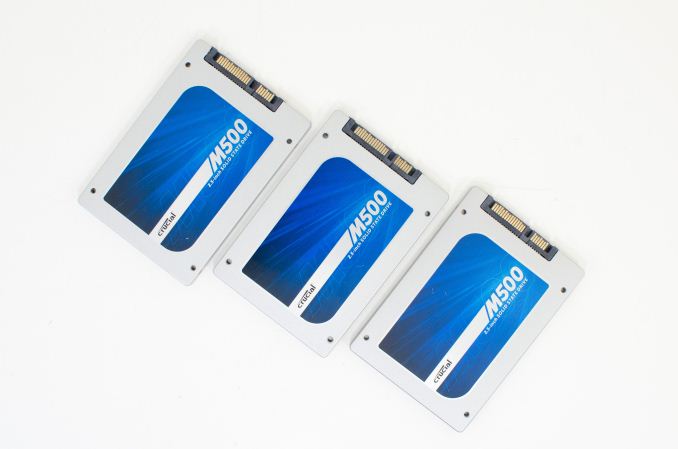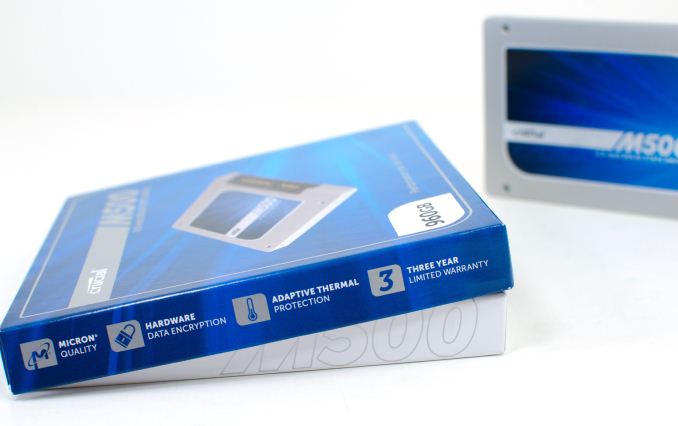The Crucial/Micron M500 Review (960GB, 480GB, 240GB, 120GB)
by Anand Lal Shimpi on April 9, 2013 9:59 AM ESTFinal Words
For SSDs to become more cost effective they need to implement higher density NAND, which is often at odds with performance, endurance or both. Samsung chose the endurance side of the equation, but kept performance largely intact with the vanilla 840. Given that most client workloads aren't write heavy, the tradeoff made a lot of sense. With the M500, Crucial came at the problem from the performance angle. Keep endurance the same, but sacrifice performance in order to hit the right cost target. In the long run I suspect it'll need to be a combination of both approaches, but for now that leaves us in a unique position with the M500.
The M500's performance is by no means bad, but it's definitely slower than the competition. Crucial targeted Samsung's SSD 840, but in most cases the TLC based 840 is faster than the M500. There's probably some room for improvement in the M500's firmware, but there's no escaping the fact that read, program and erase latencies are all higher as a result of the move to larger pages/blocks with the drive's 128Gbit NAND die. The benefit to all of this should be cost, but we'll have to wait and see just how competitive the smaller capacities of the M500 are on cost.
The saving grace when it comes to the M500's performance, at least compared to Samsung's offerings, is worst case IO consistency in a full drive state. If you have the luxury of keeping around 20% of your drive free, Samsung maintains its performance advantage. If, on the other hand, you plan on using almost all of your drive's capacity - the M500 does have better behavior than even the 840 Pro. It's an interesting tradeoff, but going forward I feel like we're going to have to start distinguishing between both usage models. The M500 definitely isn't the best when it comes to delivering both high performance and consistent IO, that title continues to belong to Corsair with its Link_A_Media based Neutron drive. But among the current crop of non-SandForce tier 1 SSD manufacturers, the M500 does reasonably well.
The encryption story on the M500 is potentially very interesting. Assuming the drive is indeed fully supported as a Windows 8 eDrive like Crucial claims, the M500 would be the obvious choice for anyone who had to run with BitLocker enabled. The prospect of seeing more SSDs with hardware encryption that can be leveraged by the OS is downright exciting. Honestly I wasn't aware of the eDrive spec until testing the M500, but now I want to see something similar from Apple as well.
Power consumption is another potentially good story from Crucial, assuming idle power in a notebook is truly as low as it claims. Power under load is competitive with Samsung's SSD 840 Pro, and actually even lower than the vanilla 840. Given that neither of those drives is particularly power hungry, the M500 does well there. Support for DevSleep is a nice addition. The combination of the M500's encryption support and DevSleep give us a good idea of two platform features that we should hope to see from all modern drives during this next generation.
All of this brings us to recommendation time. The easiest of the M500 drives to recommend and dismiss are the highest and lowest capacity versions, respectively. The 960GB M500 is the cheapest 1TB-class SSD I've seen to date, and it's likely the best buy if you need that much storage in a single drive. Performance still falls short of the fastest drives in this space, but if you need the capacity and plan on using all of it the M500 is really the only game in town. I've been hammering on the 960GB very hard over the past few days and while it hasn't been long enough to clear the drive as reliable, so far it's handled everything I've thrown at it very well (including our new Destroyer benchmark). I know I've personally been waiting for a good, high-capacity SSD for notebook use and based on my options today, I'd have no issues going with the 960GB M500.
On the other side of the fence, the 120GB version sacrifices a lot of performance as a result of only using a total of 8 NAND die within the drive. Unless its street price is significantly more attractive than its MSRP, I don't see a reason to choose the 120GB M500.
Recommending the two middle capacities (240/480GB) will really depend on street pricing. Based on their MSRPs, the M500 doesn't appear to be any more competitive here. I suspect that we will see closer-to-840 pricing after a few weeks of being in the channel, at which point they may be worth another look. For now, we play the waiting game.












111 Comments
View All Comments
gochichi - Wednesday, April 10, 2013 - link
Crucial is in a unique position. I don't think people care about performance numbers. What we know is that SSD s are either a nightmare or a dream. What we want is a dream. People want simple understandable marketing.My favorite SSD so far is a Monster Digital 240gb Daytona. It has been absolutely flawless. But the 120 gb version is a lemon. Reselling the drive would never happen. Monster Digital is probably not going to be a player in the SSD market going forward.
My point is, what's at stake here is who's the next Seagate? The next Western Digital? Of SSDs. Samsung can do no wrong, much like Apple. And yet this weird little company called Crucial has enjoyed tremendous on-the-street notoriety with their M4 series.
As far as I can tell the M4 is a little outdated. My question is why not release an M5? Why 500? Why waste so much consumer goodwill? Is it just that this drive isn't good? Or not good enough for proper successorship?
I don't know why I've purchased crucial drives before, it started with a little 64gb m4. The I just trust the m4 line. My point is why does Crucial carry bad models and why so many confusing numbers? The m4 is a golden opropportunity. Where's that trusty m5 follow up? Samsung has understandable generations and model lines. They're making sure they're the Western Digital of SSD. Why isn't Crucial doing similar?
Solid State Brain - Wednesday, April 10, 2013 - link
The reason why it's M500 and not M5 is probably because of Plextor:http://www.plextor-digital.com/index.php/en/M5-Pro...
Kristian Vättö - Thursday, April 11, 2013 - link
Crucial isn't exactly small, they are a subsidiary of Micron. As said above, Plextor has M5S and M5 Pro SSDs so M5 would have been very confusing, hence the M500. The OEM version of M4 was C400, so it's actually not that confusing.FunBunny2 - Thursday, April 11, 2013 - link
-- My point is, what's at stake here is who's the next Seagate? The next Western Digital? Of SSDs.Getting harder to say. The three well known public companies doing SSD (mostly) as such, STEC, OCZ, Fusion-io, have been missing all targets for a least a couple of quarters. Violin may or may not IPO in the next few months.
The reasonable answer is that there won't be a Seagate or WDC for SSD. It's well understood how to take commodity HDD to Enterprise Drive, using tighter QA and some incrementally better parts at modest cost. With SSD, as this review shows, "progress" in feature shrink isn't improving any of the factors at lower cost. It is quite perverse. The NAND suppliers will come to dominate consumer SSD, with performance asymptotically approaching a bit better than current HDD, with a price premium. Look for TLC, with huge erase blocks, long latencies, slowing controllers (having to do all that much more work to get around the NAND).
Enterprise SSD will likely fade away, to be replaced by NAND arrays, along the line of the Sun/Oracle device, which has been around for a few years.
dilidolo - Wednesday, April 10, 2013 - link
Everyone else mentioned Super Cap in M500 but not here. I just want to confirm if it's true.Tjalve - Friday, April 12, 2013 - link
Therte seems to be capacitors on the drive. But i would like to know aswell.klmccaughey - Thursday, April 11, 2013 - link
The pricing is WAY off. £274 ($420) for 240GB one in the UK!!! They must be mad.philipma1957 - Friday, April 12, 2013 - link
the 960gb was 570 usd at amazon. at your price x 4 it would be $1680. that is a lot of value tax.philipma1957 - Friday, April 12, 2013 - link
I just went on amazon uk the 240gb is 168 pounds the 480gb is 321 pounds. some what better. then the price you foundKarol Bulova - Saturday, April 13, 2013 - link
I own Samsung 840Pro (it had cash-back recently) so I welcome this comments from articles on Anandtech.'The 840 Pro does an amazing job with 25% additional spare area however, something that can't be said for the M500. '
'if you simply set aside 25% of the total NAND capacity as spare area' performance improves'
I am running Win8 64bit with TRIM enabled - what is unclear for me though, is:
1. is spare are just free not occupied space on the HDD (e.g. when it is not full)
2. or is it just un-formatted partition (without a filesystem - thus no files expect for header)
3. or there shouldn't be any partition at all - and drive will somehow figure it up that I just magically allocated spare area
Or is there some utility for Samsung to do spare area? Please advice - from what I understand I should reinstall windows and choose 192GB as my main drive capacity instead of full!